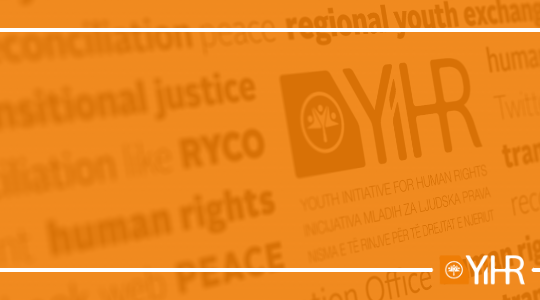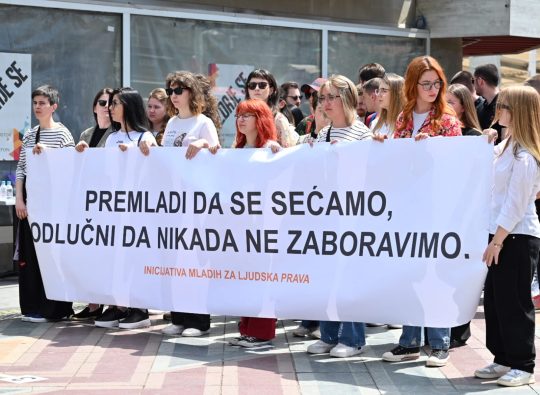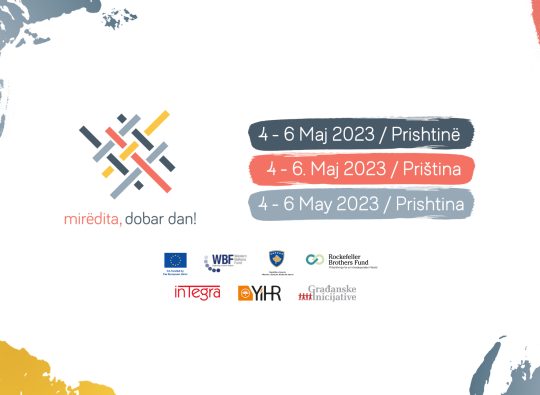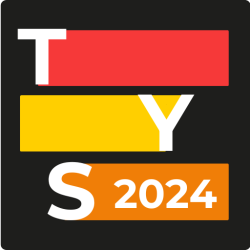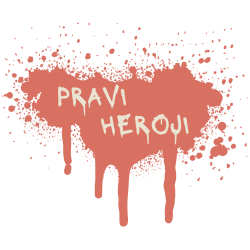The first stop on the study visit was at the “Once Upon A Time and Never Again” exhibit, which the Humanitarian Law Center curated. The exhibition displays artifacts from children killed during the most recent war in Kosovo. The students had the opportunity to spend time in the exhibit and read the stories of the children killed. Bekim Blakaj, from the Humanitarian Law Center, explained the exhibit’s significance and gave students a presentation on transitional justice. Blakaj overall message to the students was that the only way to “break the circle of violence” in the region was to establish the facts of what happened.
After the visit to “Once Upon A Time and Never Again,” students had the opportunity to meet with Slavisa Mladenović, the Language Commissioner of Kosovo, who explained the law of language in Kosovo and the failure of implementation within the country. Mladenović explained that the Law of language was adopted by the international community before Kosovo declared independence and, therefore, it was “not a battle won by the minorities,” nor was it majority communities giving a right to the minorities, instead the Law of languages was implemented simply to gain independence. Mladenović continued to explain that there was no respect for the Law on any level, that very few institutions do a good job implementing the Law, and that there is a severe lack of administrative capacity for effective institutionalization of the Law. While lack of implementation remains an issue, Mladenović sees the implementation of language reform as a path of reconciliation, stating that it will build trust among communities at some level, as right now there is a complete lack of trust between communities, and between communities and institutions because there is a severe lack of communication. Mladenović ended his session by explaining that he believes that if students have the opportunity to learn other languages, they would, as they do not carry the same prejudices as older generations.
Additionally, students had another opportunity to engage with the Humanitarian Law Center by discussing legal realities for transitional justice with Amer Alija. Alija explained the different legal avenues, including local prosecution of war crimes, the International Criminal Tribunal for the Former Yugoslavia (ICTY), and the Kosovo Specialist Chambers, and how many individuals had been convicted in each court. Furthermore, he explains the issues with the prosecution, such as the reality that international prosecutors often left their jobs before trials were finished, which dragged out the trials even further, changing laws and regulations about trying individuals in absentia, and that there are severe issues with extradition due to the complete lack of trust between Serbia and Kosovo. Alija finished his talk by explaining that the issues surrounding the justice system were ongoing; however, criminal trials and convictions are a crucial part of the transitional justice process.
Memory Walk
On the last day of the study visit program, students participated in a memory walk around Pristina led by Korab Krasniqi. Throughout the walk, students discussed which narratives were present in public spaces and what these narratives told the general population about the history and reality of Kosovo. Krasniqi also emphasized the importance of alternative narratives to promote truth and undermine nationalist tendencies. On the walk, students stopped at various monuments and public spaces, including the National Library, the unfinished Orthodox church on the University of Pristina campus, and a plaque that reminds students of missing people from the war, specifically, the disappearance of prominent Albanian academics. The group also discussed the monument to brotherhood and unity. Krasniqi explained the different interpretations of the monument and the attempts individuals have tried to dismantle it over the years. After discussing the legacy of brotherhood and unity in the region and how this narrative has changed over the years, the group moved to the missing person’s landmark and discussed the monument is small, off to the side, and not as noticeable as other monuments, but also how both Serbs and Albanians came together over the issue of missing persons. Krasniqi then explained the life of Ibrahim Rugova and Zahir Pajaziti at their respective monuments, explained the importance of which state leaders are memorialized in public spaces, and how their size and position change the narratives surrounding both figures. Finally, students had the opportunity to see the Newborn Monument and understand how the monument has become a space for social and political narrative as each year; it is redecorated to reflect salient political issues such as visa liberalization, the war in Ukraine, and missing people. The memory walk ended at the Heroinat monument.
To end the study visit, students had dinner with Dani Ilazi to discuss EU integration. Ilazi presented his theory that regional cooperation was the only path toward the EU due to recent trends in the EU in which countries have been admitted in blocks of countries. He stressed that regional cooperation was the only way to grow, prosper, and move forward. Finally, the students asked about the rise of nationalism in the region, and Ilazi came to a similar conclusion that regional cooperation would help quell the rise of nationalism.
The study visit provided students with an immense amount of information and time to discuss issues and get to know each other as fellow human beings.

